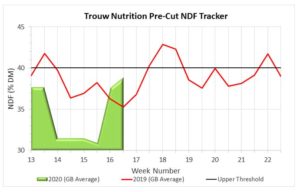Across the UK this week, we have seen an average increase of 20kg DM/ha/day of grass growth, totalling to an average of 47kg DM/ha/day. Compared to the same period in 2019 and the 6-year average, this is 6-7kg higher. Yorkshire saw the lowest growth rates of 34kg DM/ha/day, with the East grass growth rates nearly double at 60kg DM/ha/day.
Grass growth is continued to grow at an accelerated rate with the continued warm weather and the forecasted outbreaks of rain over the following week. It is a high- risk time for grass staggers, ensure adequate magnesium intakes to limit and mitigate risk.
An increase of 1.55kg/day to M+ 10 litres compared to last week has been seen in potential MYFG. This is double of that seen during the same period last year and M+ 4.2 litres greater than the 6-year average.
This could be a result of the increase in available DM. Similar to last week, there is huge variation in MYFG across regions- Scotland at M+ 0.6 litres and the East at M+ 19.8 litres. More samples were received in the Trouw Lab this week, although there was no sample from the North West region.
*Please use the MYFG figure in consideration with the limited number of samples being received in the lab, making it difficult to draw conclusions and therefore year on year differences may seem large.
Remaining at high levels are RFC content, fibre index and acid load, which also means that there is a high risk for depressions in butterfats. Control measures such as increasing dietary fibre and the inclusion of rumen buffers should be considered. Compared to last week’s figures, the overall grass quality has seen a dip, ME down by 0.4MJ/kg DM.
Monitoring sward height can help improve grass utilization and quality, enabling for informed management decision to be implemented such as changes in stocking density.
Latest Pre-Cut tracker

The lab at Trouw has received the highest number of samples during this latest period which allows for a better insight into the development of NDF content of cutting fields. These have shown an increase to an average of 38.84%. This highlights that many first cuts across the country may be ready to cut; the optimal NDF content threshold is between 38-40%. Sending in pre-cut samples allows informed decisions to be made and can help minimize the risk of crop becoming too mature, compromising quality, especially as the forecast over the next week is favourable.
Source: Trouw Nutrition GB

